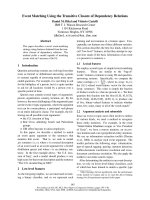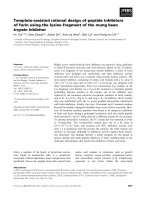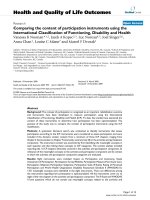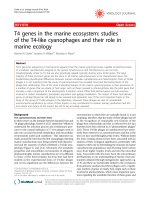Using the Mathermatical Models to Study the Marine Ecosystem of Binh THuan - Ninh Thuan Sea Area and...
Bạn đang xem bản rút gọn của tài liệu. Xem và tải ngay bản đầy đủ của tài liệu tại đây (1.19 MB, 9 trang )
VNU.
JOURNAL
USING
OF
SCIENCE,
THE
MARINE
SEA
Nat
Sci, t XVII, n92 - 2001
MATHEMATICAL
ECOSYSTEM
AREA
AND
OF
TAM
MODELS
BINH
STUDY
THUAN-NINH
GIANG-CAU
Doan
TO
HAI
THE
THUAN
LAGOON
Bo
Faculty of Hydro Meteorology and Oceanography
College of Natural Sciences,
Abstract:
The marine
Vietnam National
Unive
Hanoi
stem model has been established on the basis mathemat-
ical simulation for the material transformation through compounds
The phosphor cycle is chosen as an example for eco-hydrodynamic
of the system.
model. In the
cycle, phosphorus element is transformed through five compounds (Phytoplankton,
Zooplankton, Detritus, Dissolved Organic and Inorganic phosphorus) by different
bio-chemical processes.
The
eco-hydrodynamic
model
has
been
established
on the
basis turbulent diffuse model in combination with the material transformation model
(as phosphor cycle model).
The general model is analyzed into simple models,
are applied to the sea area of Binh
Hai lagoon of Thua
Thuan-Ninh
Thien-Hue province.
which
Thuan province and Tam Giang-Cau
The obtained results are very important to
study the biological and ecological characteristics of marine plankton communities,
to simulate and predict the variation of living and non-living compounds, especially,
to monitor
the marine
environment
and ecosystem.
1. Introduction
Recently, mathematical models and numerical methods have been widely used for
researching the marine ecosystems. One of those is to solve the Eco-hydrodynamic prob-
lems that have been established on the basis of combination between diffusion model and
the model of material transformation in the marine ecosystem. The results coming from
the application of the model allow us to look totally and optically at the development
tendency
of the system
under the influence of the marine
thermo-hydrodynamic
condi-
tions. The results also allow us to determine the basic and general relationship in the
marine ecosystem, to predict the variation of living and non-living compounds in the sea,
especially to monitor marine environment and ecosystem.
In this paper, some kinds of marine ecological model and Eco-hydrodynamic model
are introduced. The applications of these models to Binh Thuan-Ninh Thuan sea area
Giang-Cau
Hai lagoon
in order to study characteristics and variation of com-
N
and Tam
8
Doan
Bo
pounds of marine ecosystem, especially primary productivity and in order to study the
ecological effects of physical, environmental conditions show that the good results have
been obtained.
2.
Equations
of the models
Marine
Ecological Model
The marine ecological model has been established on the basis of mathematical simulation for the material transformation through the compounds of the marine ecosystem,
in which the living compounds are only limited by phytoplankton and zooplankton. In this
study, the phosphorus transformation cycle is chosen as an experiment for application of
the Eco-hydrodynamic model. In the cycle, the phosphorus (an essential element for life)
is transformed
five compounds
through
C{i
processes
bio-chemical
= 1...5) by different
K;(j = 0...7), fig. 1 [1]. The cycles for transformation of other elements are considered in
the same way. Combining the cycles to each other, we have the general model for material
transformation in the marine ecosystem.
Legend:
Cy,
Cy
Cs — Biomass
Cy
Cay
Phytoplankton, — Zooplankton
concentration
of Detritus,
Organic and Inorganic
respectively,
Ka
Ky,
Ky
-
Own
of
and
Dissolved
Phosphorus,
speeds
of
respiration,
photosvnthesis
and
natural
death
of — Phytoplankton
population, respectively.
Ky Ky Ks - Own speed of water
filtering,
death
of
respectively,
respiration
and
natural
Zooplankton — population,
Ko, Ky ~ Own speed of decomposition
Phosphorus (C4)
«
~
Inorg. Diss.
Phosphorus (C5)
Fig.
is following:
model
mineralization
of — organic
by,
b3 - Coefficient
of selecting
compounds, respectively.
bs
Phytoplankton and Detritus as natural
food by Zooplankton,
lạ(b5) |
1: Schema of phosphorus
Mathematical
and
by. bs, be b> ~ Ratio of transformation
into different material kinds.
bs
Hae of Phosphorus in organic
compounds
transformation cycle in marine ecos;
to simulate dynamic
of material
dC; /dt = Rys(i = 1...n)
transformation
em
in the c
(1)
Using
where
the mathematical
C,
is the
biomass
models
to study
(or concentration)
the marine
ecosystem...
of it? compound;
variation of biomass (or concentration) of i” compound.
cycle, the mathematical model is following:
R,
- the
9
total
speed
of
For phosphorus transformation
dC, /dt = Ry = (Ky — Ko — Ka — b K2C2)Cy
dCy/dt = Re{(byCy
+ b3C3)b2
Kg — Ky — Ks|Cz
dCy/dt ~ Ry = KyCy + KxCo + (bxCy + bgCs)(1 — bp)bg oC
dC, /dt = Rg
= (byCy
+ b3C3)(1
— b2)(1 — bg )bg K2C2
— b3 K2C2C3 — KeCa
+ bsbg K3Ce2 + bobs KeC3+
+ brbg KoCy — KrCy
dCs/dt — Rs = K7C4
+ (1 = bs)bgh3C2
+ (1 — bg )bg K6C3
+ (1 — b7)bgKoCy
— bg Ki Cy
‘The speeds of A); depends on environmental conditions, they can be
-
using some empirical formulae, as follows [4, 5, 6]:
2
Ko(1/day) = PoE xp|Qo(T — 20) — Uo.Ln(MP)|
WW (1/day) = Ky max-min|A, B,C, D|
i
Pi
W2(m* /ing.day)
0
if S=0
Kemax-5(2— $/5))/51
if
0
if
S;
1ƒ
S > S2
max
Kamax/[1
+ Pa(S ~ S2)]
Ks(1/day) = Py.ExplQs(T — 20) — Us.Ln(MZ)|
Kas(1/day) = Pas.exp(Qas.T —Uss.7)
No7(1/day) = Po.7 Exp(Qo71)
where:
Ky max(1/day) = Exp(QiT' — U;)
"“Ắ=....
e
N=
rao!
ĐỘC
No
SIO
3,720: ) 8 ~ PTO," ~ NaN? * Bie tSiOD
NHị + NÓ; + NÓ¿
8=Œ\+Ca
Nam =4
X.Exp|0,08(Tinin — 7)
Ä
if TeTnu
if Thìn ST! STmex
X.Erp|0,08ŒT — Tiax)| — Qa(T — Thấy)
if
X = 0,000682F'xp|-U2.Ln(MZ)|
In the empirical formulae:
- the minimal and maximal
of zooplankton
ically
T(°C) is the environmental temperature; Tinin, Tmax (°C)
temperature
in the optimal
population, respectively; Q,Q«
active radiation
and
T > Tinax
temperature
interval for growth
(cal/em?/min) - energy of photosynthet-
half-saturation coefficient
of light
intensity,
respectively;
€ -
10
Doan
base of natural
logarithm;
Bo
PO4, NH,, NO2,
NOs, SiOs(mgP, N, Si/m*) - concentration
nitrite, nitrat and silicon, respectively (here, PO4 is compound
of phosphate, ammonium,
C5); Px, Nx, Si * (mgP,N,Si/m’)- half-saturation coefficient for the salts of phosphor,
nitrogen and silicon, respectively; $;,S2 (mg)- optimal interval of food concentration of
zooplankton; Mp, Mz - the mean size of phytoplankton cell and zooplankton individual,
respectively; Py, QK,UK(k = 0...7) - experimental coefficients.
Eco-hydrodynamic
model
By adding the functions F, of system (2) into the equations of diffusion model, the
general model to simulate for time and space variation of compounds under the influence
of thermo-hydrodynamic
processes can be obtained, as follows:
Tên
aC,
+V loi
tí
Oy
OC
và (AE
3
(3)
8 2 (atémY sn
0
Oc;
ằ
where U,V, W
are the components of velocity of current in the x,y,z directions, respectively; W, - the sedimentation velocity ofi"th compound (W, = 0 for dissolved compounds);
Axi, Azi - the horizontal and vertical turbulent diffusion coefficients of it” compound. The
boundary and initial conditions are chosen suitable with the normal diffusion model.
ion of current, diffusion coeflicients, water
intensity of photosynthetically active radiation at the water surface, con-
‘The input
temperature,
values are velocity and dire
centration of PO4, N H4, NO2, NO3, SiO3... depending on the objective of study and the
source data, the model can be simplified for some certain cases of study.
3. Some
study
Dynamic
results
model for material transformation
in the phosphorus
cycle
The model (2) with initial conditions C; = C? at t = fo is solved by Runge-Kutta
method.
The solutions are the time variations of biomass
(or concentration)
of the com-
pounds in the phosphorus cycle. The biological productivity of plankton community and
the ecological effects of autotrophic and first heterotrophic hierarchy are also calculated
from the model.
The mentioned model is named PMOD and has been applied to the sea area of
Binh Thuan-Ninh
Thuan
province in order to study the annual
of phosphorus cycle [1]. The results are depicted in figure 2.
variations of compounds
Using
the mathematical
SO)
models
to study
the marine
ecosystem...
11
——Phytoplankton (10 mg/m3)
—o— Zooplankton (mg/m3)
——— Detritus (.100 mg/m3)
40 +
—x— Organic Phosphorus (mgP/m3)
—#— Inorganic Phosphorus (mgP/m3)
30
20
Or
1
2
Fig.
3
4
5
6
7
8
9
10
11
Month
2: The annual variation of compounds of phosphorus cycle
at the sea area of Binh Thuan-Ninh Thuan province (results estimated by PMOD)
The
Model
of competition
in marine
plankton
communities
Separating
first two
equations of the system (2), we have model of competition in marine plankton communities (the model is called PLAMOD). The model is, the same as the model of ” prey-predator”
relationship of Voltera.
ton as "prey”.
In the model, the concentration of detritus (C's) is determined through the
value of BOD or COD.
Thua
Where, zooplankton is considered as ” predator” and phytoplank-
Thien-Hue
The PLAMOD
has been applied to Tam Giang-Cau Hai lagoon,
province in order to study
cal productivity of plankton community [3].
the daily variations of biomass and biologi-
The input
environmental data at 24-hours continuous stations.
values of the PLAMOD
The results are depicted in figure 3.
30
20
10
0
+
-10
= = Biomass (100 mg-wet/m3)
Rough Primary Productivity (mgC/m3/hour)
oO Pure Primary Productyvity (mgC/m3/hour)
--*--
Temperature
(oC)
Inorganic Phosphorus (mgP/m3)
Fig. 3: Daily variation of biomass and primary productivity
of phytoplankton at Thuan An Stations (Tam Giang-Cau Hai lagoon)
in October
are the
1995 (results estimated by PLAMOD)
12
Doan
Two-dimensions
model for distribution
of the compounds
Bo
in phosphorus
cycle
Integrate equation (3) in the vertical direction from free surface to depth D and
consider the steady state, diffusion coefficient is constant, to have the two-dimension steady
model,
This model is named P2DMOD,
9C;
V ,8G:
9 Ox TU
Oy
The
boundary
%C,
=A
conditions
as follows:
used
„0Ý 1 ĐỤC,
D
_ 3C,
Oy?
in this model
are:
aC;
+ Ri
(4)
ae
+ b(0C;/OL)
with
= land b
0 if at the solid boundary, a = 0 and b
1 if at the open boundary, L
is the unit vector normal to the open boundary, Cy is the given value of C; at the solid
boundary,
In the case of having no values Cf we can use the condition OC, /On
0 (nis
the unit vector normal to the solid boundary).
The P2DMOD can be reduced to solve the competition problem in the plankton
community. In this case, system (4) includes 2 equations, one for phytoplankton, another
The model has also
been applied for Binh Thuan-Ninh Thuan sea area in order to estimate ecological role of
for zooplankton,
R;
and
Ry are first two equation
from system
(2).
upwelling in the primary production process [2]. The input data got from investigation in
upwelling sea area in 8/1992.
|[BIOMASS
Figure 4 shows the results.
OF aac
x0
(mg-weUm3)
{
A
| Phan Thieta
-
joe
1075
1080
~706
1085
300,
|
1
|
`
1090
eee
Tuy Ph
"Phan Thiets,/~)
1095
BY
wy
|
110
1080
1000
1085
sary
pry
1090
Phan Rang gˆÝ
Ca Na!
Tuy Phong /
Phan Ri > "66
L2
105
1080
500
ae
+ Phụ Quy
1085
⁄
|
1100
4: Distribution of biomass of phytoplankton
Let
1075
1080
`
30
1090
Phan Rang
eae,
if
|
NĨ
1095
|
1100
\;
Tuy Phong
1) Phan Thiet,
1000
1095
bo
Cim2. day)
D
sa
„í
PRODUCTIVITY
(mg
`
f
FY SECONDARY
CaNas
1500/2000
fp
B
Phan Thieta
Phan Rang“
Cc
OF ZOOPL, ANKTONS
(mg-wet/m3)
re
(Phu Quy.
(mg-C/m2.day)
Fig.
1
|
500
“PRIMARY PRODUCTIVITY
1075
J
Phan Reng
CaNas
Tuy Phong
Phan Rif
vi BIOMASS
\
|
wis
CaNa!.-
1085
(A), of zooplankton
5
“ˆ ”
7 / ey
‘i
Ae
“7°40
|
Nero
~ 4030
1095
1100
(B) in the surface layer
and total of primary productivity (C), of secondary productivity of zooplankton (D) in Im?
water column of the photosynthetically layer in Binh Thuan-Ninh Thuan sea area
in Aug, 1992 (results estimated by P2DMOD)
Using
the mathematical
One-dimension
models
to study
the marine
ecosystem...
13
model for vertical distribution of the compounds
in cycle
The governing equations:
yo
sự
(w +u)ŠtOz
s2 (25 Oz ‘) t Ry
values Co,
(5)
Oz
Boundary condition:
- At the free surface (z = 0),C, = Cio
given
"
(Cio
is the given
values).
If there are no
.¡(0Œ,/8z) — WiC, = 0.
the balance condition is applied:
- At the level 2 = D (D is under boundary of photosynthesis layer):
the given
values Cjp,
the equation
will be taken as C’, — Cp;
that the vertical gradients of compounds
deep-water
area,
where
the
light
can
are zero (OC',/0z =
not
reach,
the biomass
if there are
if there are not, we assume
0).
can
If D is bottom
be taken
in the
to be
zero
(Cy = Cy = 0).
‘This model is called PIDMOD.
Thuan-Ninh Thuan
sea are shown
The results of application of this model for Binh
in figure 5.
mựụC/m /day
0
40
80
+
120
58
ð& 8
0
-100
Fig. 5:
Vertical profile of primary productivity of phytoplankton at Binh ‘ThuanNinh Thuan
sea area in Aug.
1992 results estimated by PIDMOD)
4. Conclusion
The
Eco-hydrodynamic
fusion model
in combination
model
has been established on the basis of turbulent dif-
with the phosphorus
transformation model.
Four simplified
forms of the model were also given, as follows: the model for material transformation in
the phosphorus cycle (PMOD), the model of competition in marine plankton communities
(PLAMOD), the two-dimensions model (P2D MOD) and one-dimension model (PIDMOD)
for distribution of the compounds
in phosphorus cycle.
The models were applied to the sea area of Binh Thuan-Ninh
Tam Giang-Cau Hai lagoon of Thua Thien-Hue province.
important
for studying
the biological
and ecological
Thuan province and
The received results are very
characteristics of marine
plankton
14
Doan
Bo
communities and also for simulating and predicting the variation of living and non-living
compounds,
especially, for monitoring the marine environment
and ecosystem.
We thank the Foundational Research Program 1998-2000 for financial assistance to
carry out this research,
Department
Hanoi.
We also wish to acknowledge
the helpful comments of Scientists of
of Oceanography, College of Natural Sciences, Vietnam National University,
REFERENCES
. Đoàn Bộ. Tính tốn biến đổi năm khối lượng sinh vật nổi bằng mơ hình chu trình
phốtpho trong hệ sinh thái vùng biển Thuận
Hải, Tạp chí Sinh học, Hà Nội, T15,
No3(1993), tr. 7-20.
Đồn Bộ. Mơ hình tốn học về sự phân bố sinh vật nổi và năng suất sinh học sơ
cấp vùng nước trồi thềm lục địa Nam Trung bộ, Tạp chí Sinh học, Hà Nội, T.19,
No4(1997), tr. 35-42.
. Đồn Bộ. Nghiên cứu năng suất sinh học quần xã plankton vùng đầm pha Tam
Giang-Cầu Hai bằng phương pháp mơ hình tốn, Tạp chí Khoa học, Dại học Quốc
gia Hà Nội, Tuyển
tập các cơng trình hội nghị khoa học Trường, Đại học Khoa học
Tự nhiên, ngành Khí tượng-Thuỷ văn và Hải dương học, 4-1998, tr. 1-7.
Jinghui Guo, Karina Yew Hoong Gin, Hin Fatt Cheong.
A Size-based
Model
of Plankton Dynamics in Sub-tropical Ocean Waters, Proceeding of Conference:
Oceanology International 1997 Pacific Rim, Vol. 1: Extending the Reach of Ocean
Technologies, Singapore
1997, pp. 45-56.
. J. Kishi, Nakata, Ishikawa.
Sensitivity analysis of a coastal marine ecosystem,
Journal of the Oceanographic Society of Japan, Vol. 37(1981), pp. 120-134.
‘Takashi
Asaeda,
Truong
Van
Bon.
Modeling
the effects of macrophytes
blooming in eutrophic shallow lake, Ecological Modeling,
on alga
No 104(1997), pp.
261-
287.
II, n°2- 2001
SU DUNG MO HINH TOAN TRONG NGHIEN CUU HE SINH THAI
VUNG BIỂN BÌNH THUẬN-NINH THUẬN VÀ DAM PHA TAM GIANG-CAU HAI
Doan Bo
Khoa Khí tượng Thuỷ văn &_ Hải dương hoc
Đại học Khoa học Tự nhiên - Đại học Quốc gia Hà Nội
Mơ
hình sinh thái biển được
xảy dựng
trên cơ sở mơ phỏng
tốn
học q trình
chuyển hố vật chất qua các hợp phần của hệ. oO đây, chu trình chuyển hod phosphor
đã được xây dựng làm thí nghiệm cho việc triển khai bài tốn sinh thái-thuỷ động lực.
“Trong chu trình, nguyên tố phosphor được chuyển hoá qua 5 hợp phần (thực vật nổi,
Using
the mathematical
models
to study
the marine
ecosystem...
15
động vật nói, chất vấn, phosphor hữu cơ và võ cơ hồ tan) nhờ các q trình sinh hố
khác nhan, Mơ hình sinh thái thuỷ động lực được xây dựng trên cơ sở kết hợp mỏ hình
chu trinh chuy
vat chất (ở đảy là chủ trình phosphor) với mơ hình khuếch tán rối,
nó cho phép đánh giá ảnh hưởng của các điều kiện vật lý môi trường tới chiều hướng.
phát
triển của hệ sinh thái
vùng biển nghiên cứu.
Mo hình chung được phần tích thành các mỏ hình giản đơn
và các mơ hình giản
đơn này đã được triển khai tại vùng biển Bình Thuận-Ninh Thuận và vùng đầm phá
‘Tam € ang-Cầu Hai (mơ hình động lực
r chuyển hố vật chất trong chu trinh phosphor,
mỏ hình anh tranh trong quần xã plankton biển, mơ hình 2 chiều ngang, 1 chiều thẳng
đứng phản bố các
hợp phần của chu trình phosphor và năng suất sinh học plankton).
Các
kết quả nhận được rất có ý nghĩa trong việc nghiên cứu định lượng các đặc trưng sinh
học, sinh thái học quần xã plankton biển, tính tốn và dự báo biến động các hợp phần
vỏ sinh, hữu sinh, đặc biệt trong việc
kết quả nà,
kiểm sốt mơi trường và hệ sinh thái biển.
cũng mở ra triển vọng sử dụng
trong nghiên cứu hệ
sinh thái
ác mơ hình tốn
vùng biển nhiệt đới
et Nam.
và các phương
Những
pháp số









